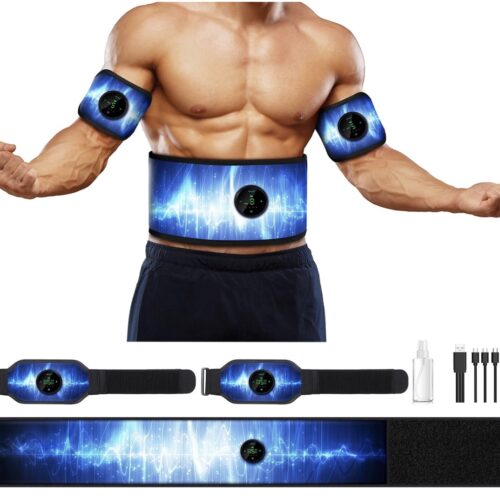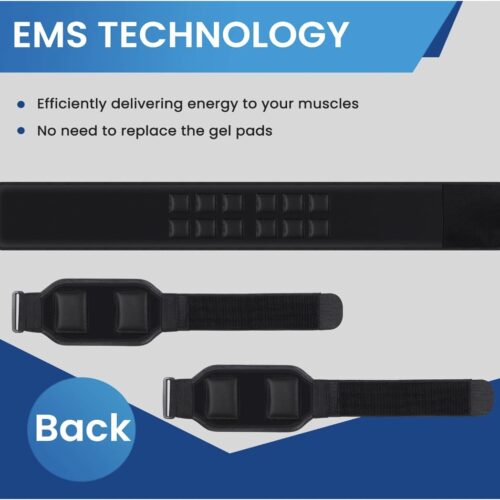Electric muscle stimulation (EMS) is a technique where equipment is placed on the skin to send electric currents to certain muscle groups.
These currents make the muscles contract, which can help reduce discomfort and pain. Athletes often use EMS to help repair muscle fibers faster, which can shorten their recovery time.
Now, let’s take a look at what studies have discovered about EMS.
For Untrained Older Adults
Reverse sarcopenia
Sarcopenia, the age-related loss of skeletal muscle mass and strength, poses a significant challenge for older individuals.
EMS emerges as an effective intervention against age-related muscle loss and sarcopenia. In a 2013 study, researchers investigated the effects of 12 months of whole-body electromyostimulation (WB-EMS) exercise on appendicular muscle mass and abdominal fat mass in individuals at risk for sarcopenia and abdominal obesity, who were unable or unwilling to engage in conventional exercise.
Results after 12 months revealed notable differences between groups. The WB-EMS group exhibited positive changes in appendicular muscle mass (0.5% ± 2.0% compared to -0.8% ± 2.0% in the control group, P=0.025) and abdominal fat mass (-1.2% ± 5.9% compared to 2.4% ± 5.8% in the control group, P=0.038).
This suggests that EMS could serve as a valuable strategy to counteract the effects of sarcopenia and preserve muscle mass in aging populations.
Reduce body fat
A 2016 study from the Institute of Medical Physics in Germany examined the impact of EMS Fitness and protein supplementation on sarcopenic obese men aged over 70.
One hundred men in this age group were randomly divided into three groups: one received 1.5 sessions of 20-minute EMS workouts for 16 weeks along with 1.8 g/kg protein supplementation, another group received only the protein supplement, and the third group served as the control. Dietary intake was loosely monitored.
The main focus was on changes in total body fat mass after 16 weeks. Participants were also assessed for trunk fat mass, waist circumference, cholesterol, and triglycerides.
Results showed that the EMS+protein group experienced a 6.7% reduction in total body fat, a decrease of 0.69 kg in trunk body fat, and a decrease of 1.94 cm in waist circumference. In comparison, the protein-only group had a 3.6% reduction in total body fat, a decrease of 0.26 kg in trunk body fat, and a decrease of 0.91 cm in waist circumference. Meanwhile, the control group saw increases of 1.6% in total body fat and 0.23 kg in trunk fat.
Prevent muscle loss
A study published by the National Library of Medicine aimed to investigate whether electrical stimulation could combat muscle decline in older adults. It stressed the importance of preserving muscle integrity as aging makes muscle fibers more susceptible to deterioration, leading to weakness and fat accumulation.
While regular exercise remains the mainstay for preventing muscle decline, the study demonstrated that electrical stimulation is beneficial in countering neuromuscular disability and preserving muscle mass in older adults. Additionally, individuals with knee osteoarthritis experience relief and therapeutic advantages from electrical stimulation.
The study involved 16 senior participants aged 70 and above, all free from preexisting physical conditions. Over a nine-week period, they underwent regular neuromuscular electrical stimulation training, completing 24 sessions with electrodes placed on their thighs.
Following the training, participants’ muscle strength was evaluated through exercises such as sitting and standing up and walking stairs, compared to muscle biopsies taken before the training.
As participants were able to perform exercises more frequently without experiencing fatigue, the study concluded that electrical stimulation contributes to maintaining muscle mass and fostering muscle adaptation.
For Fit and Active Adults
Improve sports performance
A study published in the Journal of Strength and Conditioning explored if Electrical Muscle Stimulation (EMS) could enhance elite athletes’ performance.
The study found that even elite athletes, who are already very fit, can significantly improve their strength levels with EMS, just like untrained individuals.
The researchers concluded that EMS presents a promising alternative to traditional strength training for improving strength and motor abilities in athletes.
Increase muscle endurance
Research has shown that electrical stimulation training can enhance both muscle endurance and strength. In a 2005 study, participants using abdominal stimulators experienced slight reductions in waist size, despite no change in overall weight.
During the study, 24 adults were split into two groups. One group used ab stimulators five days a week for eight weeks, while the other did not engage in any abdominal exercises. Results showed significant improvements in the group using ab stimulators, including enhanced posture and a 58% increase in abdominal strength. They also exhibited a 100% increase in abdominal endurance and reduced their waists by an average of 3.5 centimeters (approximately 1 ⅓ inches).
Participants who used ab stimulators reported improvements in posture, firmer abdominal muscles, and a more toned appearance.
Improve body strength
A field test conducted at the University of Bayreuth aimed to assess the impact of EMS training on various aspects including body strength, general wellbeing, body composition, body awareness, muscle imbalances, mood, back pain, and incontinence.
According to the researchers, participants experienced a remarkable 12% increase in total maximal strength and a significant 69% improvement in overall muscular endurance. Moreover, participants reported enhanced feelings about their bodies, with 83% experiencing reduced body stress, 89% feeling stronger stability, and 83% reporting higher overall body performance.
Furthermore, 87% of participants noted favorable improvements in body shape, and 90% expressed that EMS treatments were an effective method for enhancing general fitness and wellbeing.
For Weight Loss
Fat Burning
In a clinical trial conducted in Germany, untrained middle-aged people underwent whole-body EMS. The study revealed significant changes in body perception, with 87% reporting a shift in attitude and 89% noticing a firmer physique.
For women, the average reduction in waist and hip measurements was 1.5 inches. Male participants experienced a decrease of 2-3 centimeters in waist circumference and 1-2 cm in various muscle areas.
After just four weeks, overweight participants shed an average of 3.5 pounds and 9% body fat, along with 6.5 inches from the waist and 2 inches from the upper arms.
Even those over 65 saw significant improvements. At the lowest exercise intensity, they lost an average of 6.8% abdominal fat and 6 inches from the waist.
Reduce the levels of abdominal obesity
In a 2015 study titled “Effects of high-frequency current therapy on abdominal obesity in young women: a randomized controlled trial,” researchers investigated the effectiveness of Electrical Muscle Stimulation (EMS) in reducing abdominal obesity in young women.
During the study, participants underwent 30-minute sessions of high-frequency current therapy using electrodes placed on their stomachs three times a week for six weeks. After this period, researchers measured changes in waist circumference, body mass index, subcutaneous fat mass, and total body fat percentage.
Remarkably, without any changes to their exercise or diet routines, EMS significantly reduced waist circumference, abdominal obesity, subcutaneous fat mass, and overall body fat percentage. The study concluded that “The use of high-frequency current therapy may be beneficial for reducing the levels of abdominal obesity in young women.”
Our Ab Stimulators
Our ab stimulators are scientifically proven to work. You can use the stimulators anytime and anywhere, making it easy to keep up with your training routine. Regular use of the ab stimulators is key to seeing fast results.















